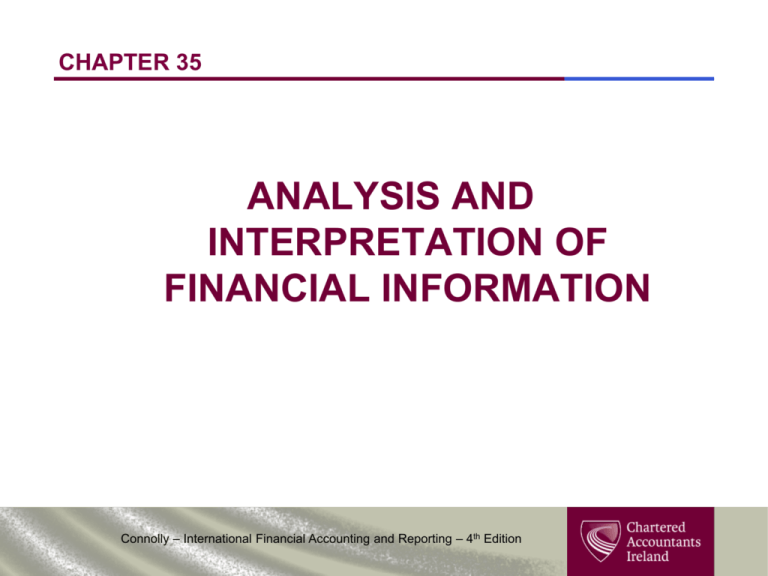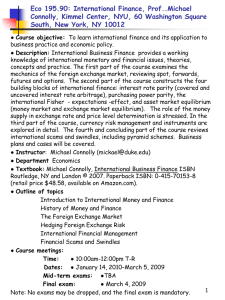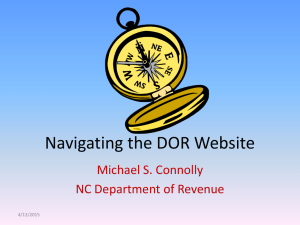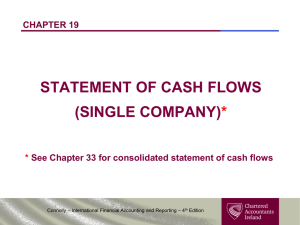Ratios - Chartered Accountants Ireland
advertisement

CHAPTER 35 ANALYSIS AND INTERPRETATION OF FINANCIAL INFORMATION Connolly – International Financial Accounting and Reporting – 4th Edition 35.1 INTRODUCTION • • • Financial information is prepared to satisfy the needs of different stakeholders (Conceptual Framework for Financial Reporting 2010) What is the significance of the figures contained in the financial statements and how might they? Ratio analysis is a tool used to conduct a quantitative analysis of information in an entity’s financial statements Analysis of financial statements and the use of ratios (Section 35.2) Categories and calculation of ratios (Section 35.3) Financial balance and overtrading (Section 35.4) Accounting policies and limitations of ratio analysis (Section 35.5) Connolly – International Financial Accounting and Reporting – 4th Edition 35.2 ANALYSIS OF FINANCIAL STATEMENTS AND USE OF RATIOS • • • • Must compare ‘like with like’ (See Example 35.1) Internal use – past performance, against budget External use – other companies, industry Don’t view in isolation Read the ‘whole’ annual report, including the narrative information View in context of the economy, government legislation, industry and firm’s life cycle & policies • Tell the story – look beyond the pure numbers Connolly – International Financial Accounting and Reporting – 4th Edition Example 35.1: Comparing like with like Company X began trading in 2006. Due to significant growth in the first 3 years, Company X engaged in an aggressive acquisition policy in 2012. This led to €100,000 of one-time charges on a total net profit before tax of €50,000. Shareholders equity amounted to €1,500,000. In this scenario, Return on Capital Employed (ROCE), which is calculated by dividing shareholders’ equity into profit (See Section 35.3, efficiency ratios) before one-time charges would be 10%, whilst after would be 3.33%. When comparing 2012 ratios to past years or to industry averages, it is therefore important to compare ROCE before one-time charges as these are not standard costs. Connolly – International Financial Accounting and Reporting – 4th Edition 35.3 CATEGORIES AND CALCULATIONS OF RATIOS 1. Profitability 2. Liquidity 3. Efficiency 4. Growth 5. Investment 6. Cash flow Connolly – International Financial Accounting and Reporting – 4th Edition 1. Profitability i.e. relationship between profitability and revenue Consider in conjunction with liquidity • • • Gross Profit % GP / R Net Profit % PBIT / R Contribution % C/R Connolly – International Financial Accounting and Reporting – 4th Edition 2. Liquidity i.e. how accessible the company’s cash is Link with profitability • • • • Current CA / CL (1.5 – 2) Acid test or Quick CA – Inv. / CL (1 – 0.7) Receivables Ratio (Tr. Rec. / Cr. Sales) x 365 Tr. Payables Ratio (Tr. Pay. / Cr. Purch) x 365 Be aware of individual components, window dressing (See Example 35.2) and credit facilities Connolly – International Financial Accounting and Reporting – 4th Edition Example 35.2: Window dressing Before After Repayment of €400 trade payables Current assets €1,400 – €400 €1,000 Current liabilities €1,000 – €400 €600 Current ratio 1.4 Connolly – International Financial Accounting and Reporting – 4th Edition 1.7 3. Efficiency i.e. the effective utilisation of assets Return is relative to the amount invested • • • • • ROCE (Primary ratio) (See Table 35.1) Revenue / Non-current Assets (tangible?) Revenue / Net-current Assets Inventory turnover [(Inventory / Material CoS) x 365] Non-current Assets / TA Connolly – International Financial Accounting and Reporting – 4th Edition Table 35.1: ROCE definitions Profit Profit before tax and interest Capital Employed Gross assets = Non-current assets and current assets Profit before tax and interest Net assets = Gross assets less current liabilities Profit after tax Shareholders’ capital = Total share capital and reserves Profit after tax and preference dividends Shareholders’ equity capital = Ordinary share capital plus reserves Connolly – International Financial Accounting and Reporting – 4th Edition 4. Growth Areas to examine include: • • • • Revenue PBT Non-current Assets Total capital employed View in context of: • • • Industry Company life cycle Market share v Profits Connolly – International Financial Accounting and Reporting – 4th Edition 5. Investment i.e. From an investor’s perspective • • • • • • • • EPS PAT – NCI & PD / No. Ord. Shares Earnings Yield EPS / MPOS Dividend Yield DPOS / MPOS Dividend Cover PAT & PD / DPOS PE Ratio MPOS / EPS (See Example 35.3) Gearing Ratio TD / Equity Debt Ratio TD / TA Interest Cover PBIT / Interest (See Example 35.4) Connolly – International Financial Accounting and Reporting – 4th Edition Example 35.3: Interpreting the P/E ratio For the year ended 31 December 20X6, X plc had: (i) (ii) (iii) (iv) EPS = 10 cents; Overall market P/E ratio = 10; P/E ratio = 20 (because market expects above average growth); Market price at 30 April 2012 (date of publication of previous year’s accounts) = €2; (v) During the year, X plc does even better than expected and by 29 April 2013 the share price is up to €3, therefore giving a P/E ratio of 30 (based on EPS for year ended 31 December 2011); (vi) Year ended 31 December 2012 EPS = 15 cents, announced on 30 April 2013. This is in line with expectations so share price is unchanged and P/E ratio drops again to 20 (€3/15 cents). Connolly – International Financial Accounting and Reporting – 4th Edition Example 35.4: Gearing and EPS Two companies, A plc and B plc, both have capital of €10,000. A plc has it all in the form of equity shares of €1 each, B plc has 5,000 €1 equity shares and €5,000 of 10% debentures. Both companies earn profits of €5,000 in year 1 and €2,000 in year 2. Tax is assumed at 35% and the dividend paid is 10 cents per share. The capital position is therefore as follows: Shares Debentures A plc € 10,000 – 10,000 Requirement What is the EPS in each year? Connolly – International Financial Accounting and Reporting – 4th Edition B plc € 5,000 5,000 10,000 Example 35.4: Gearing and EPS Solution Profit before tax and debenture interest Debenture interest Taxation (35%) Earnings Dividend (10%) Retained profits Earnings per share A plc B plc Year 1 Year 2 Year 1 Year 2 € € € € 5,000 2,000 5,000 2,000 – – 500 500 4,500 1,500 1,750 700 1,575 525 3,250 1,300 2,925 975 1,000 1,000 500 500 2,250 300 2,425 475 32.5c Connolly – International Financial Accounting and Reporting – 4th Edition 13c 58.5c 19.5c Example 35.4: Gearing and EPS Solution (Cont’d) The effects of gearing can be seen to be as follows: (a) Debenture interest is an allowable deduction before taxation, whereas dividends are paid out of profits after taxation; company B has consistently higher retained profits than Company A. (b) Earnings of a highly geared company are more sensitive to profit changes. This is illustrated as follows: A plc B plc Change in profit before interest and taxation -60% -60% Change in earnings -60% -662/3% The reason for the fluctuation is obviously the element of debenture interest which must be paid regardless of profit level. This more than proportionate change in earnings is important in relation to the share price of the companies. Many investors value their shares by applying a multiple (known as the P/E ratio) to the earnings per share. Applying a multiple of say 10 to the EPS disclosed above would indicate share valuations as follows: A plc B plc Year 1 2 1 2 Share price €3.25 €1.30 €5.85 €1.95 Thus the share price of a highly geared company will often be more volatile than a company with only a small amount of gearing. Connolly – International Financial Accounting and Reporting – 4th Edition 6. Cash flows i.e. analyses the cash inflow / outflow during the year • Statement of cash flows (IAS 7) (See Chapters 19 and 33) • Reconciliation of operating profit Investing activities – acquisition and disposal of non current assets and other investments Financing activities – equity capital and borrowings Ratios Funds generated by operating activities / Inventory Net cash inflow/outflow before financing / Revenue Connolly – International Financial Accounting and Reporting – 4th Edition 35.4 FINANCIAL BALANCE AND OVERTRADING Financial balance: i.e. balance between various forms of finance LT finance for LT investment (debt & equity) Use of o/d and trade credit Connolly – International Financial Accounting and Reporting – 4th Edition 35.4 FINANCIAL BALANCE AND OVERTRADING Overtrading: i.e. When a company expands its turnover rapidly without securing additional long-term capital adequate for its needs Symptoms • • • • inventory increasing > sales receivables increasing > sales cash and liquid assets declining rapidly payables increasing rapidly Connolly – International Financial Accounting and Reporting – 4th Edition 35.5 ACCOUNTING POLICIES AND LIMITATIONS OF RATIO ANALYSIS Accounting policies: • Effect of choice, and changes therein (IAS 8) (See Chapter 8) i.e. different accounting standards allow a choice, and involve estimates & judgement Connolly – International Financial Accounting and Reporting – 4th Edition 35.5 ACCOUNTING POLICIES AND LIMITATIONS OF RATIO ANALYSIS Limitations: • • • • • • • Consistency Reporting date Window dressing Accounting policies – estimates and judgements Life cycle Age of assets Deliberate policies Connolly – International Financial Accounting and Reporting – 4th Edition The following information has been extracted from the financial statements of six companies, each of which operates in a different industry. The information is expressed as a percentage of net assets. The industries in which the companies operate are: A. General manufacturing; B. Property investment and rental; C. House building; D. Whiskey distiller; E. Brewer and owner of public houses; and, F. Supermarkets. Company Land and buildings Plant, machinery and vehicles Inventory & WIP Trade receivables Cash at bank Trade payables Bank overdraft Net assets 1 % 150 5 9 1 165 2 % 10 10 80 14 1 115 3 % 80 10 10 2 8 110 4 % 2 4 108 35 1 150 5 % 30 28 45 32 5 140 6 % 80 15 10 12 3 120 (10) (55) 100 (10) (5) 100 (10) (-) 100 (33) (17) 100 (30) (10) 100 (20) (-) 100 Connolly – International Financial Accounting and Reporting – 4th Edition






